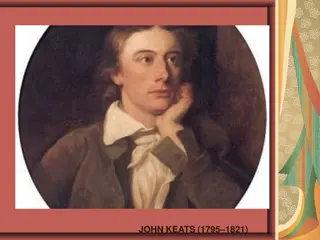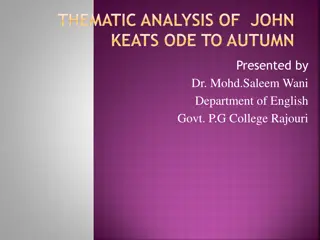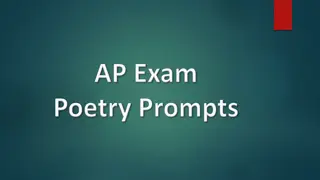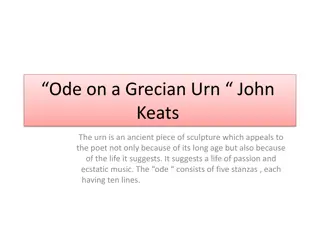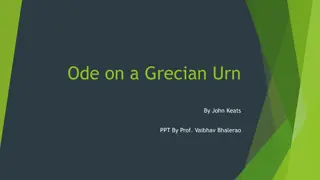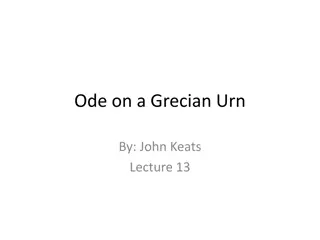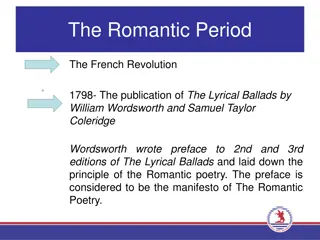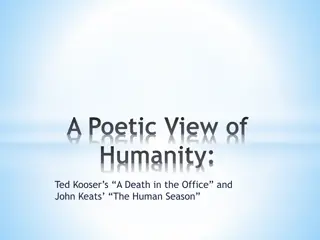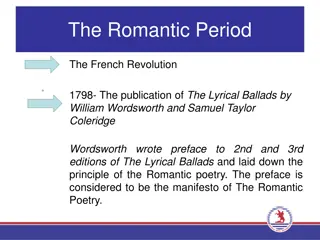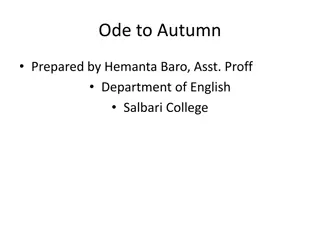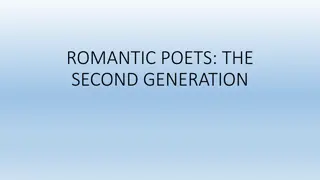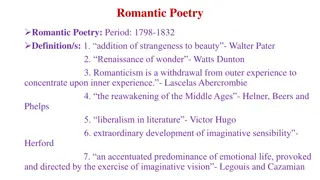Understanding John Keats and "A Thing of Beauty
John Keats, a prominent Romantic poet, is known for his sensual imagery and iconic odes. His poem "A Thing of Beauty" from "Endymion" emphasizes the eternal joy beautiful things bring, contrasting negativity with positivity and natural beauty. Keats' work continues to be celebrated in English litera
0 views • 7 slides
Thematic Analysis of Keats' Ode to Autumn in the Context of Romantic Literature
The thematic analysis of John Keats' "Ode to Autumn" explores the poem's reflection on the beauty of seasonal transitions, emphasizing the melancholic yet serene nature of autumn. Presented by Dr. Mohd Saleem Wani, the analysis delves into Keats' ability to find beauty in the changing landscape and
0 views • 10 slides
Exploring Poetic Techniques in Various Poems
This analysis delves into different poems by renowned poets, examining the intricate use of figurative language, poetic devices, and literary techniques to convey complex themes such as family relationships, desires, coming of age, and personal situations. Through an in-depth comparison and contrast
0 views • 10 slides
Themes of Mortality and Transcendence in Keats' "Ode to a Nightingale
Keats' "Ode to a Nightingale" explores themes of poetic inspiration, the escapism of art, and the inevitability of death. The poet grapples with the contrast between the timeless beauty of the nightingale's song and the fleeting nature of human existence, contemplating the transient nature of life a
0 views • 11 slides
Analysis of 'Ode on a Grecian Urn' by John Keats
Keats' 'Ode on a Grecian Urn' explores the timeless beauty and permanence of art compared to the transient nature of human life. Through vivid imagery and paradoxes, Keats delves into the themes of love, beauty, and the power of artistic representation. The urn, depicted as a silent storyteller, cap
1 views • 7 slides
The Life and Poetry of John Keats: A Master of Beauty and Mystery
Born in 1795, John Keats faced early hardships and pursued poetry despite a medical background. His exquisite Odes reflect a profound aesthetic sense. Keats' life was tragically cut short by tuberculosis in 1821, leaving behind a legacy of beauty, truth, and negative capability in his work.
0 views • 9 slides
Ode on a Grecian Urn by John Keats - Analysis and Interpretation
In the "Ode on a Grecian Urn" by John Keats, the poet reflects on the timeless beauty captured on an ancient urn. Through vivid imagery and lyrical language, Keats explores the themes of art, beauty, love, and immortality. The urn becomes a symbol of eternal preservation, freezing moments in time th
0 views • 12 slides
Exploring John Keats's Negative Capability Theory in "Ode on a Grecian Urn
John Keats, known for his melancholic temperament, delved into the concept of Negative Capability in his poetry, particularly evident in "Ode on a Grecian Urn." This theory emphasizes the poet's ability to transcend rationality and immerse in intense emotions without the need for analysis or judgmen
0 views • 29 slides
The Romantics: Poetry and Revolution in the French Revolution Era
The Romantic Period was marked by the publication of "The Lyrical Ballads" by Wordsworth and Coleridge, setting the principles of Romantic poetry. Emphasizing emotions and nature, Romantic poets like Wordsworth, Shelley, Coleridge, and Keats used everyday life and rural language to express their fee
0 views • 6 slides
Contrasting Perspectives on Death: Kooser's A Death in the Office vs. Keats' The Human Seasons
Ted Kooser's "A Death in the Office" and John Keats' "The Human Seasons" present differing views on mortality. Kooser portrays death as a routine process, while Keats sees it as a natural phase of life. Despite not explicitly mentioning death, both poems evoke contemplation on the inevitability of o
0 views • 12 slides
The Romantic Period: Influence of the French Revolution on Poetry
The French Revolution of 1798 had a profound impact on poetry during the Romantic Period, exemplified by the publication of "Lyrical Ballads" by William Wordsworth and Samuel Taylor Coleridge. Wordsworth's preface to the collection laid out the principles of Romantic poetry, emphasizing the expressi
0 views • 6 slides
Romantic Poetry and Poets of the Romantic Era
Romantic poetry is characterized by emotional spontaneity, self-expression, and a deep connection to nature. Key poets of the Romantic era include William Wordsworth, S.T. Coleridge, P.B. Shelley, and John Keats. Their works reflect themes of imagination, childhood, and individual feeling, shaping t
0 views • 8 slides
Ode to Autumn by John Keats - Summary and Analysis
Ode to Autumn by John Keats is a captivating poem that beautifully captures the essence of the autumn season. The poem is divided into three eleven-line stanzas, each depicting the progression of autumn from the late maturation of crops to the approaching winter. Through rich imagery and personifica
0 views • 7 slides
The Second Generation of Romantic Poets: A Revolution in Poetry and Ideals
The second generation of Romantic poets, including Keats, Byron, and Shelley, rebelled against societal norms, championing freedom, individuality, and social change. Their poetry reflects a struggle with language's limitations in expressing profound emotions and ideas. Percy Bysshe Shelley emerges a
0 views • 10 slides
Exploring John Keats' Poetry and Romanticism in "On the Grasshopper and Cricket
Dive into the world of John Keats' poetry with a focus on "On the Grasshopper and Cricket," exploring themes of nature, beauty, and seasonal symbolism. Understand the Romantic Age context and discuss the significance of symbols like the grasshopper and cricket in conveying deeper meanings within the
0 views • 9 slides
Exploring the Romantic Era: Poetry, History, and Major Poets
A detailed exploration of Romantic Poetry from 1798-1832, encompassing the defining characteristics, historical background, major poets including Wordsworth and Keats, and the influence of key events like the French Revolution. Romanticism is characterized by subjectivity, imagination, love for the
0 views • 4 slides
